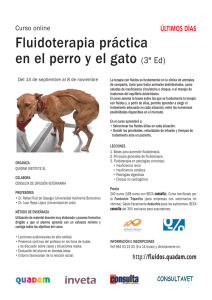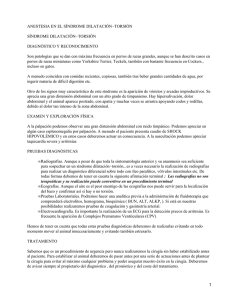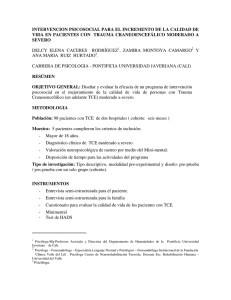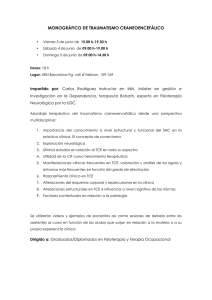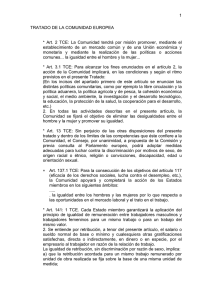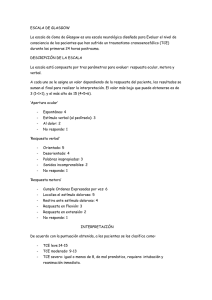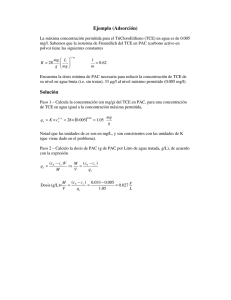FLUIDOTERAPIA EXTRAHOSPITALARIA EN EL TRAUMA GRAVE
Anuncio
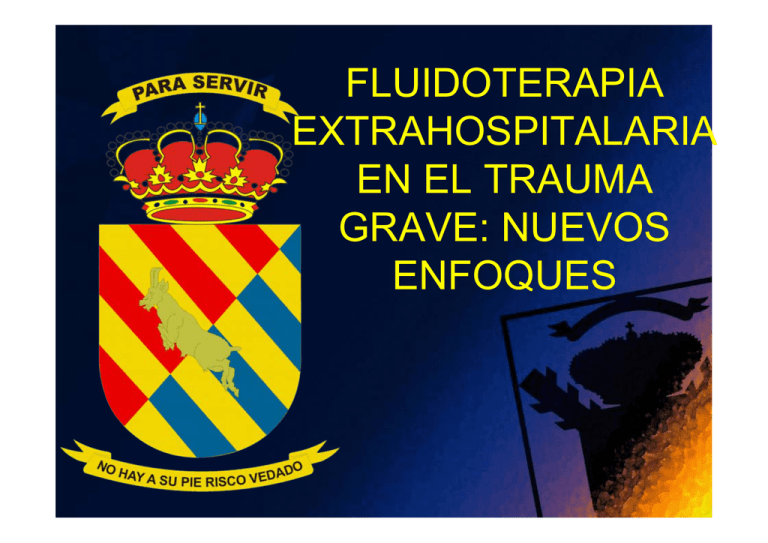
FLUIDOTERAPIA EXTRAHOSPITALARIA EN EL TRAUMA GRAVE: NUEVOS ENFOQUES •EPIDEMIOLOGÍA DEL TRAUMA GRAVE. •FLUIDOTERAPIA EN EL SHOCK TRAUMÁTICO. •FLUIDOTERÁPIA EN EL TRAUMATISMO CRANEOENCEFÁLICO •FLUIDOTERAPIA EN EL PACIENTE QUEMADO. •CONCLUSIONES •Lesiones por causas externas, 5ª causa de muerte en España •40 % de las muertes corresponden a menores de 40 años, representando en este grupo la 1ª causa de muerte •La atención a las secuelas representa en algunos países el 2% del PIB. •TCE 1ª causa de muerte pediátrica 35 •Alta prevalencia del TCE en nuestra 30 sociedad • Trauma Raqui-medular 20-30/106 . 25 20 15 % 10 5 0 Acc. Traf. Caidas Veneno otros CAUSAS DEL SHOCK TRAUMÁTICO: •NEUMOTÓRAX A TENSIÓN •SHOCK OBSTRUCTIVO •TAPONAMIENTO CARDIACO •EMBOLISMO PULMONAR •SHOCK CARDIOGÉNICO •CONTUSIÓN CARDIACA •SHOCK DISTRIBUTIVO TRAUMATISMO RAQUI-MEDULAR •LESIONES VASCULARES •SHOCK HIPOVOLÉMICO •LESIONES ORTOPÉDICAS •LESIONES EN ÓRGANOS Y VÍSCERAS ¾LA INDICACIÓN DE FLUIDOTERAPIA EXTRAHOSPITALARIA EN EL PACIENTE HIPOVOLÉMICO ES CONTROVERTIDA. ¾EXISTEN ESTUDIOS EN LA DECADA DE LOS 90 QUE DEMUESTRAN LA NO MEJORÍA DE LA SUPERVIVENCIA DE ESTOS PACIENTES POR RECIBIR TRATAMIENTO CON FLUIDOS. (1) ¾ATLS RECOMIENDA OBTENCIÓN DE 2 VÍAS VENOSAS PERIFÉRICAS GRUESAS Y LA INFUSIÓN DE 20-30 Ml/Kg. EN 15 MIN. BOLO CRISTALOIDES ¾EL CRISTALOIDE DE ELECCIÓN ES EL RINGER LACTATO (2) ¾REPOSICIÓN 3:1 (2) (1) TINTINALLI. MEDICINA DE URGENCIAS 6ª EDICIÓN 2005 (2) ADVANCED TRAUMA LIFE SUPPORT. 2005 ESTUDIOS EN MODELO ANIMAL RESPUESTA AL SHOCK HIPOVOLÉMICO ¾5 Grupos: no fluidos, fluidos inmediatos, 30 min, 45 min, 60 min. ¾ Presión arterial, niveles de lactato y hematocrito no diferencia significativa en los grupos que recibieron fluidos, pero sí con el que no recibió fluidos ¾El nivel de citokinas proinflamatorias fue mayor en los grupos con fluidoterapia tardía, aumentando su concentración proporcionalmente al tiempo de espera del tratamiento. Lee, Chien-Chang MD, et al. Delayed Fluid Resuscitation in Hemorrhagic Shock Induces Proinflammatory Cytokine Response. Annals of Emergency Medicine. 49(1):37-44, January 2007 IMPACTO DE LOS FLUIDOS EN EL SHOCK HIPOVOLÉMICO: ¾3 Grupos. Hemorragia incontrolada.Sin Tto.; Fluidoterapia controlada y Fluidoterapia agresiva. ¾Mejoría significativa de supervivencia con fluidoterapia. ¾Apoptosis significativamente menor en el caso de la fluidoterapia controlada vs. fluidoterapia agresiva. Experimental Study of Controlled Fluid Resuscitation in the Treatment of Severe and Uncontrolled Hemorrhagic Shock. Journal of Trauma-Injury Infection & Critical Care. 63(4):798-804, October 2007Lu, Yuan-Qiang MD et al. FLUIDOTERAPIA AGRESIVA Y VELOCIDAD DE INFUSIÓN ¾Hemorragia de 15 ml/kg en hombre de 70 Kg. Durante 30 min. (1050 ml) ¾La reposición con cristaloides debe realizarse en el intervalo de 40 a 80 ml/kg/h ¾Mayores velocidades no mejoran los resultados de la reposición. ¾Fluidoterapia agresiva de más de 2 horas es inefectiva. Tatara, T. *; Tsunetoh, T.; Tashiro, C. Crystalloid infusion rate during fluid resuscitation from acute haemorrhage. BJA: British Journal of Anaesthesia. 99(2):212-217, August 2007.V FLUIDOTERAPIA AGRESIVA Y VELOCIDAD DE INFUSIÓN RECOMENDACIÓN ATLS: VELOCIDAD MEDIA DE INFUSIÓN CRISTALOIDES MEDIANTE CATÉTERES SOBRE AGUJA: Cateter iv 18 g iv 16 g iv 14 g iv Gravedad 80 cm 50-60 ml/min 90-125 ml/min 125-160 ml/min Presión 300 mmHg 120-180 ml/min 200-250 ml/min 400-500 ml/min. (1) TINTINALLI. MEDICINA DE URGENCIAS 6ª EDICIÓN 2005 CONSECUENCIAS DE LA FLUIDOTERAPIA AGRESIVA EN EL TRAUMA GRAVE: - Complicaciones pulmonares. - Efectos sobre la coagulación y la respuesta inmunitaria e inflamatoria. - Relación con síndrome compartimental abdominal. RINGER LACTATO => SUERO SALINO FISIOLÓGICO=> Su aporte excesivo provoca y agrava la acidosis metabólica por exceso de cloro. •Favorece el edema al aportar agua libre. •Aporta potasio y calcio que en situación de acidosis y con politrasfusión no lo hace muy adecuado. Cotton, Bryan A.; Guy, Jeffrey S.; Morris, John A. Jr; Abumrad, Naji N. THE CELLULAR, METABOLIC, AND SYSTEMIC CONSEQUENCES OF AGGRESSIVE FLUID RESUSCITATION STRATEGIES. Shock. 26(2):115-121, August 2006 INDICACIÓN DE CRISTALOIDES O COLOIDES EN LA FLUIDOTERAPIA: ¾ESTUDIO SAFE. NO DIFERENCIA ENTRE CRISTALOIDES Y ALBÚMINAS. - 6045 pacientes. 16 hospitales Australia y Nueva Zelanda. - Albumina 4% vs. Suero salino 0,9% - End-point primario mortalidad a los 28 días. - End-point secundarios: Permanencia en UCI, estancia hospitalaria hemodiálisis requerida, duración de la V.M. y duración de la fluidoterapia. - No se encontró diferencia significativa en ninguno de los end-points. Effect of baseline serum albumin concentration on outcome of resuscitetion with albumin orSaline in patients in intesive care units: analysis of data from the saline versus albumin fluid evaluation (SAFE) study. BMJ, doi:10.1136/bmj.38985.398704C 13 oct 2006 UTILIZACIÓN DE COLOIDES EN EL TRAUMA GRAVE: -Estudios experimental sobre modelos animales. - Se ha demostrado una adecuada respuesta en los grupos tratados con coloides únicamente. - El Hex 6% (almidones) ha demostrado eficacia en dichos estudios. Parece útil el uso de coloides en pacientes que requieran fluidoterapia con restricción de volumen. P.e. Trauma torácico cerrado. Crookes, Bruce A. MD; ET AL.Building a Better Fluid for Emergency Resuscitation of Traumatic Brain Injury. Journal of Trauma-Injury Infection & Critical Care. 57(3):547-554, September 2004. SUEROS SALINOS HIPERTONICOS VS. TERÁPIA CLÁSICA. - 20 pacientes con PIC> 20 mmHg secundaria a traumatismo. - 1 infusión de 231 ml de manitol 20% vs. 1 bolo de 100 ml SSH 7,5% (20min) - Se estudio la disminución de la PIC, orina horaria, sodio sérico y osmolaridad. Ambas estrategias consiguieron disminuir la PIC de manera similar. No obstante en TCE aislado se considera el manitol primera elección ya que su acción sobre la hemodinámica cerebral favorece la oxigenación de áreas sanas del cerebro. Gilles Francony, MD et al. Equimolar doses of mannitol and hypertonic saline in the treatment of increased intracranial pressure. Crit Care Med. 2008 vol. 36 num 3 TCE ASOCIADO A HEMORRAGIA: - Estudio experimental en animales. - Grupos: Control, hemorragia, TCE, TCE+hemorragia (SSF), TCE+ Hemorragia (SSH 7,5%), TCE+ Hemorragia (l-arginina 100ml) - El estudio demuestra beneficios terapeúticos y mejor recuperación en los grupos tratados con SSH y l-arginina. - Mejoría de supervivencia neuronal en el grupo del SSH. Sell SL et al. Hypertonic resuscitation improves neuronal and behavioral outcomes after traumatic brain injury plus hemorrhage. Anesthesiology 2008 may ¾FORMULA DE PARKLAND Y REGLA DE “LOS NUEVES” Estudio retrospectivo de pacientes admitidos en centro de quemados, derivados desde Trauma Center Nivel I o atendidos en ellos. - Pacientes con SCQ <20% son sobreestimados y reciben sobrecargas de fluidos. -Pacientes con SCQ>20% son infraestimados y reciben menos cantidad de fluidos. Freiburg, Carter MD; et al. Effects of Differences in Percent Total Body Surface Area Estimation on Fluid Resuscitation of Transferred Burn Patients. Journal of Burn Care & Research. 28(1):42-48, January/February 2007 -“Fluid Creep”: - Relación con problemas respiratorios - Sd. Compartimental abdominal. Necesario buena adhesión a las guías clínicas. No sobreestimar la SCQ y el ratio de infusión controlado. Saffle, Jeffrey R. MD, FACS The Phenomenon of "Fluid Creep" in Acute Burn Resuscitation. Journal of Burn Care & Research. 28(3):382-395, May/June 2007. •LA FLUIDOTERAPIA EN EL TRAUMATIZADO GRAVE NO DEBE SER EN NINGÚN CASO AGRESIVA SINO TODO LO CONTRARIO, CONSERVADORA. •EN NINGÚN CASO LA FLUIDOTERAPIA DEBE RETRASAR LA CIRUGÍA. •EN CASO DE TCE AISLADO EL MANITOL SE SIGUE CONSIDERANDO PRIMERA OPCIÓN DE TRATAMIENTO. •SE DEBE EVITAR UN GRAN APORTE DE CRISTALOIDES, PREFIRIENDOSE SUEROS HIPERTONICOS ASOCIADOS A COLOIDES EN CASOS DE HEMORRAGIA Y TCE CON HIPOTENSIÓN. •LOS SUEROS SALINOS HIPERTONICOS SON ACEPTABLES PARA EL TRATAMIENTO DEL TCE Y REPRESENTAN UNA BUENA OPCIÓN PARA LA SANIDAD MILITAR EN TO. •NO SE DEBE SOBRESTIMAR LA SCQ DE LOS PACIENTES. •EVITAR EL FENOMENO “FLUID CREEP” POR SOBREHIDRATACIÓN.
